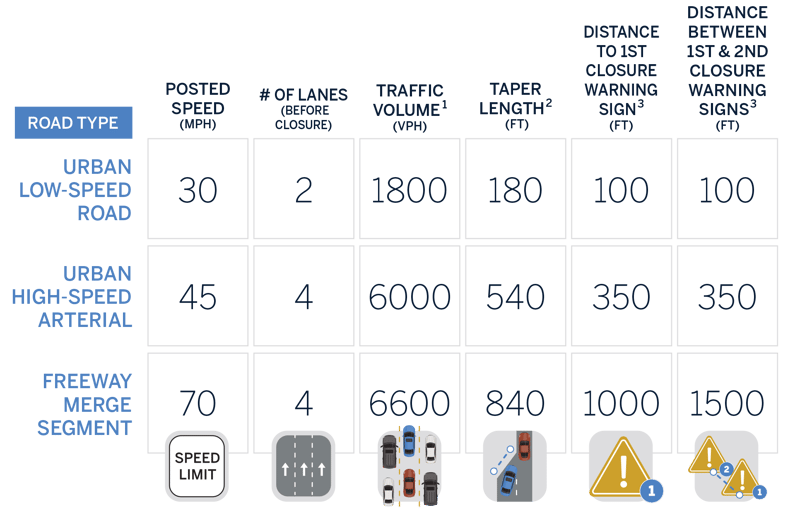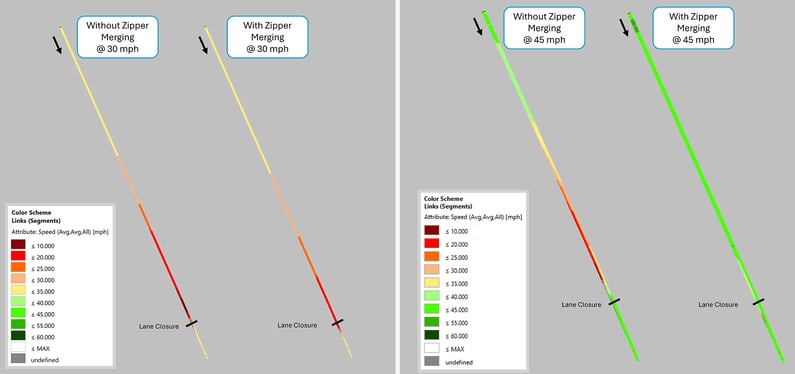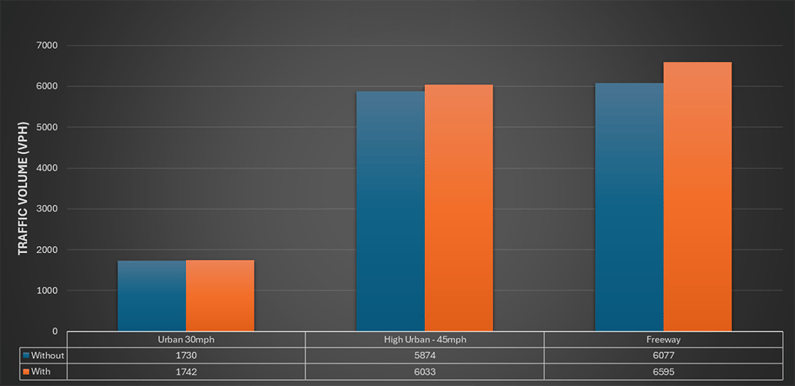When a lane closure is approaching on a highway or freeway, drivers often face a dilemma: should they merge early into the open lane, or should they use both lanes until the last moment and then alternate with the other vehicles in a zipper-like fashion? The latter option is called zipper merging, and some transportation agencies and experts advocate for its use to improve traffic flow and safety at lane closures.
Related Content: Bine Terefe - Exploring a Traffic Engineer's Vision
Defined as a method to improve traffic flow, zipper merging offers several advantages, including reduced congestion and enhanced safety, but also faces challenges with driver education and cultural acceptance. Join traffic modeling expert Bine Terefe as he explores the overall concept, outlines its advantages and disadvantages, and presents additional considerations for implementation.
Part 1 – Zipper Merging Concepts
What is Zipper Merging?
Zipper merging is a traffic management technique that allows drivers to use both lanes of a road right up to the point of lane closure where they take turns merging into the open lane. The name comes from the resemblance of the alternating merge to the “teeth” of a zipper. It is also known as late merge or dynamic late merge.
Where is This Technique Most Useful?
This form of merging is most effective in situations where there is a high volume of traffic and lane closure due to roadwork, accidents, or other incidents. It is especially beneficial when traffic volumes are close to roadway capacity. Zipper merging can also be applied to other scenarios where two lanes must merge into one, such as highway ramps, bridges, tunnels, or toll booths. However, it is not recommended for low-traffic situations, where drivers can merge early and smoothly without causing delays or conflicts.
Advantages and Disadvantages
Zipper merging has several benefits for both drivers and traffic flow, including:
- Reducing the overall length of the traffic queue, preventing congestion from spreading to other roads and intersections.
- Increasing the road capacity by maximizing the use of all available lanes.
- Improving the average travel speed, resulting in reduced travel time through the lane closure section.
- Enhancing the safety of drivers and road works by reducing the speed difference between adjacent lanes, reducing the chances of collisions due to sudden braking.
- Reducing road rage by improving fairness and cooperation among drivers as they follow a clear and simple rule of taking turns to merge.
The zipper merge technique is not a perfect solution for every traffic situation. Some possible drawbacks are:
- May cause confusion and frustration among drivers who are used to merging early or perceive late merging as rude or unfair.
- Effectiveness depends on the traffic volume and density, which may vary depending on the time of day, particular day of the week, or the season. Zipper merging may not be effective if the traffic demand is too low or too high, which may result in underutilization or overloading of the lanes.
- May not be suitable for roads with narrow or curved lanes, poor pavement conditions, or limited sight distance.
Part 2 – Evaluation of Zipper Merging Scenarios
The zipper merging technique was evaluated and compared to a non-zipper merger using detailed microsimulation models for various roadway scenarios. Microsimulation is a computer-based tool that simulates the behavior and interaction of individual vehicles and drivers within a traffic network. This method helps assess the capacity of zipper merging by modeling traffic conditions, lane closure configurations, and driver responses to the technique.
The microsimulation modeling was performed using PTV Vissim 2024 (SP05), an industry-leading traffic microsimulation software which includes features that enable precise modeling of zipper merging scenarios.
Evaluation Scenarios
Various roadway types, as shown in Table 1, were modeled to evaluate the impact of zipper merging under different roadway conditions.

1- Traffic volume for 100% capacity utilization of the downstream road section after road closure.
2- Taper length calculated based on lane width of 12ft, posted speed and table 6B-4 from MUTCD 11th edition.
3- Based on values in Exhibit 6B-1 from MIUTCD 11th edition.
Evaluation Results
The microsimulation models for each scenario were run 10 times with different random speeds. Key performance indices (KPIs) were averaged to ensure robust evaluation results. The KPIs used to evaluate and compare merging scenarios included:
- Travel time (s) & average operating speed (mph)
- 95th percentile queue length (ft)
- Volume throughput
Travel Time Evaluation Results
The evaluation of zipper merging covers travel segments of approximately 1 mile (5,283 ft) for urban low-speed and high-speed roadways and 1.65 miles (8,747 ft) for freeway merging segments. The microsimulation analyses results summarized in Table 2 consistently demonstrated reduced travel times for zipper merging scenarios compared to early (without-zipper) merging alternatives across all types of roadways. For low-speed urban roadway types, zipper merging reduces travel time through lane closure segments by 16%.
In high-speed urban roadway conditions, it achieves a 42% reduction compared to early (non-zipper) merging situations. For freeway merging segments, zipper merging reduces travel time by 54% compared to non-zipper scenarios, leading to significant increases in average operating speeds through lane closure sections across all roadway types. Figures 2, 3, and 4 depict speed heatmaps for low-speed urban, high-speed urban, and freeway merge segments, illustrating the progressive buildup of queues upstream of the lane closure location.
Travel Time(s)



Figure 3 (right): Speed heatmap for high-speed urban arterial lane closure – with & without zipper merging

Queue Length Evaluation Results
The evaluated scenarios demonstrate the highly effective role of zipper merging in minimizing upstream queue development at lane closures. In low-speed urban road sections, zipper merging reduced queue length by 22% compared to non-zipper merging scenarios. The impact of zipper merging is particularly pronounced in high-speed urban roadways and freeway merging segments. Results from Table 4 show complete elimination of queues when zipper merging is applied on high-speed urban road types. In freeway scenarios, zipper merging has reduced queues by 87% compared to early merging without zipper implementation.
Queue length (ft)

Volume Throughput Results
Volume throughput quantifies the number of vehicles passing through a congested roadway section, reflecting its operational capacity under the proposed road closure. Microsimulation results indicate that zipper merging enhances traffic volume throughput in lane closure segments. Specifically, freeway segments saw an 8.5% increase in volume throughput, while high-speed urban arterials experienced a 2.7% rise. The impact on low-speed urban arterials was comparatively minimal. Figure 5 illustrates volume throughput comparisons between zipper and non-zipper merging scenarios across different roadway types

Bringing it all Together
When tested in detailed microsimulations on various roadway types, zipper merging has delivered impactful results. It shows reduced travel time through the lane closure section by 16% for low-speed urban roads, 42% for high-speed urban arterials, and 54% for freeway merge segments, compared to the early (non-zipper) merging approach. It also shows reduced queue length by 22% for low-speed urban roads, 100% for a high-speed urban arterial, and 87% for a freeway merge segment, compared to the early (non-zipper) merging approach, further improving volume throughput on high-speed urban roads and arterials.
These results present a compelling case for optimizing traffic flow and safety during lane closures. When implemented correctly and with public awareness, zipper merging can significantly reduce congestion, improve travel times, and enhance safety for drivers and road workers. It is a technique that requires cooperation and understanding among drivers, and its success is dependent on proper education and signage while understanding the importance of considering specific road conditions and traffic patterns to ensure the best outcomes. Ultimately, this approach is a smart traffic management strategy that, when embraced, can lead to smoother and safer driving experiences.
Considerations for Effective Implementation
This is not a one-size-fits-all approach. It requires careful planning, design, and evaluation to ensure its suitability and effectiveness for different road environments and traffic patterns. Here are some considerations:
- Use at temporary or short-term lane closures, such as work zones, incidents, or bottlenecks; not recommended for long-term or permanent lane closures.
- Optimal location and length of the merge zone should balance the trade-off between maximizing road capacity and minimizing queue length and delay.
- Appropriate signage and markings should be visible, understandable, and consistent to inform and guide drivers about the zipper merging technique and the lane closure.
- Public acceptance and awareness should be fostered through education, communication, and enforcement to encourage drivers to adopt and comply with the zipper merging technique.
- Performance and impact should be continuously monitored and evaluated using data and feedback to measure the effects of zipper merging on traffic flow, safety, and driver behavior.
About the Author

Binebeb Terefe, PE*, PTOE**, is a senior traffic engineer and modeling specialist with extensive traffic and modeling expertise. He has a hands-on approach to delivering strategic travel demand and micro-simulation projects across the globe. With a comprehensive background in freeway and urban corridor optimization, his skills extend to travel demand modeling, traffic impact assessments, transportation master plan studies, and corridor traffic operations and analyses.
*Registered Professional Engineer in CO, TX

.png?width=113&name=SEH_Logo_RGB%20(1).png)
